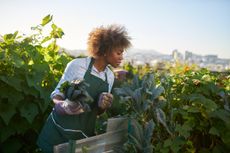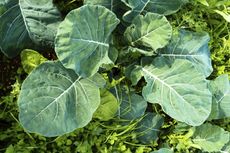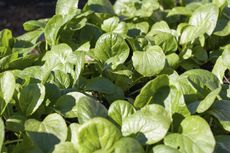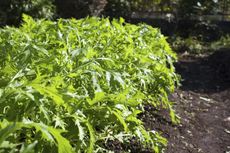Growing A Salad Bowl Garden: Learn How To Grow Greens In A Pot


You will never have an excuse again not to have a fresh green salad if you grow a salad in a pot. It's super easy, fast, and economical. Plus, growing greens in containers allows you to select the types of greens you favor rather than settling for one of those supermarket mixes. Container grown salad greens are also less expensive than purchasing those boutique baby greens as well. A salad bowl garden is really a win/win. Read on to find out how to grow greens in a pot.
Benefits of a Salad Bowl Garden
While supermarket selection is expanding all the time, there are still usually only a handful of greens available at the grocers. That’s only the tip of the iceberg. There are so many more greens to choose from and many of them are more colorful (i.e., not only more flavorful but higher in nutrition than store-bought greens). Plus, it’s easy to grow your own microgreens at a fraction of the cost. Greens can also be harvested by just plucking the leaves instead of the whole plant. That means that you have a continual supply of fresh greens when growing greens in containers. You should be able to enjoy three to four harvests from each plant, but you can also succession plant so that in another few weeks, you have another entirely new plant to harvest from. Also, by growing in pots, greens are less susceptible to being munched on by pests or afflicted with soil-borne diseases. Container grown salad greens don’t require much space or even much effort. With a rapid return, most lettuces mature from seeding in about three weeks. This also makes it the perfect fun and educational project to work on with your less-than-patient kids.
How to Grow Greens in a Pot
Lettuce is one of the oldest veggies, developed from prickly lettuce, which as its name suggests was a less than desirable green. By weeding out the less desirable traits, such as the spines, more edible lettuce was created. Today, there are hundreds of different cultivars of greens to choose from and, along with the lettuces, you may wish to grow other greens such as spinach, beet greens, kale, or Swiss chard. You may also wish to include some edible flowers or herbs to add pizzazz to your salads. Keep in mind that not every plant listed here has similar growing requirements. For instance, herbs are usually low-maintenance, drought-tolerant plants. They wouldn’t be included in with your delicate greens but could be container grown alongside the salad bowl garden. To grow salad in a pot, select a tray, pot, or window box that is at least 18 inches (46 cm.) wide and 6 to 12 inches (15-31 cm.) deep. Be sure that the container has adequate drainage holes in the bottom. Choose your greens. In addition to those previously mentioned, some of the many types include:
Likewise, you may choose to plant a “mesclun” mix, which usually includes arugula, lettuce, chervil, and endive. Fill the container with pre-moistened, good quality potting soil or one of your own makings. Sow the seeds densely with ½ inch (1 cm.) between seeds. Keep the pot moist during germination and thereafter. Thin the plants when they are a few inches (8 cm.) tall using a pair of scissors. You can then toss the thinnings into a salad as microgreens. When the plants are 4 to 6 inches (10-15 cm.) tall, fertilize them with a soluble fertilizer at half strength. Plants can be harvested after a few weeks by cutting just the leaves you want.
Gardening tips, videos, info and more delivered right to your inbox!
Sign up for the Gardening Know How newsletter today and receive a free download of our most popular eBook "How to Grow Delicious Tomatoes."

Amy Grant has been gardening for 30 years and writing for 15. A professional chef and caterer, Amy's area of expertise is culinary gardening.
-
 Urban Composting Guide: How To Compost In The Middle Of The City
Urban Composting Guide: How To Compost In The Middle Of The CityUrban composting does not have to be daunting. You can compost in the city, and maybe even try some urban worm composting!
By Mary Ellen Ellis
-
 Shrub Diseases And Pests To Watch Out For
Shrub Diseases And Pests To Watch Out ForShrub diseases and pests can be challenging. Learn how to recognize and eradicate them before they can present a danger to your plants.
By Susan Albert
-
 Substitutes For Lettuce – Growing Alternative Salad Greens
Substitutes For Lettuce – Growing Alternative Salad GreensAlternatives to lettuce are generally higher in nutrients and more flavorful. Click here for some ideas on what to use as substitutes for your lettuce.
By Amy Grant
-
 Mibuna Mustard Greens: How To Grow Mibuna Greens
Mibuna Mustard Greens: How To Grow Mibuna GreensMibuna mustard is a highly nutritious Asian green with a mild, mustardy flavor. Wondering how to grow mibuna greens? Click here.
By Mary H. Dyer
-
 Autumn Crop Greens – When To Plant Greens In The Fall
Autumn Crop Greens – When To Plant Greens In The FallYou can easily grow greens in fall. Many leafy salad greens are cool season crops that prefer the autumn temperatures. Click here for more.
By Amy Grant
-
 How To Harvest Leafy Greens – Picking Leafy Greens In The Garden
How To Harvest Leafy Greens – Picking Leafy Greens In The GardenAll leafy greens are easy to grow, rich in nutrients (although some more than others) and some can be eaten both fresh and cooked. Harvesting leafy greens is a simple matter as well. Click here if you’re interested in learning how and when to harvest garden greens.
By Amy Grant
-
 Winter Salad Greens: Tips On Growing Greens In Winter
Winter Salad Greens: Tips On Growing Greens In WinterIf you get cold winters, you're not going to be picking tomatoes in February. You may, however, be picking any leafy greens you like. If you're growing in the winter, salad greens are the way to go. Learn how to grow greens over winter here.
By Liz Baessler
-
 Komatsuna Plant Care: Tips On Growing Komatsuna Greens
Komatsuna Plant Care: Tips On Growing Komatsuna GreensI dare say most of us have never heard of growing komatsuna greens; I hadn't. When I read about them, I began to wonder what does komatsuna taste like and how do you grow it. Read on to discover a wealth of interesting komatsuna facts.
By Amy Grant
-
 Asian Mizuna Greens: How To Grow Mizuna Greens In The Garden
Asian Mizuna Greens: How To Grow Mizuna Greens In The GardenMizuna greens are a popular leafy vegetable from Asia that is used worldwide. Like many Asian greens, they are related to the more familiar mustard greens. For more information on growing mizuna greens, this article will help.
By Liz Baessler
-
 Leafy Garden Greens: Different Types Of Garden Greens
Leafy Garden Greens: Different Types Of Garden GreensWhat are greens? Leafy garden greens are more than lettuce. The types of garden greens range from the tops of edible roots to ornamental plants. Growing greens is easy, and this article will help.
By Bonnie L. Grant